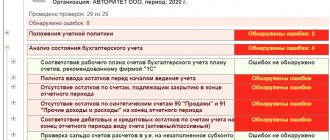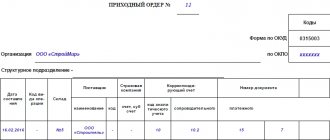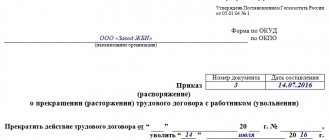Enterprises that use cars regularly record transactions that reflect the turnover of spare parts for them. In this case, it is assumed that the following basic operations with these materials are recorded:
- Posting.
- Moving from one division of the company to another.
- Write-off for repair.
Each case uses its own supporting documents. If we talk about the 3rd operation, then as a corresponding document, many companies use an independently developed form of an act of writing off spare parts for a car, the main feature of which is the justification for the need to replace the corresponding spare part.
Files for download:
general information
The act confirms the fact of the economic life of the company. Based on the act of writing off spare parts, spare parts installed in the car during repairs are written off from the balance sheet. Such paper is necessary to prove to them in case of claims from the inspection authorities that the funds were spent lawfully.
A commission may be convened to draw up the document. This can also be done by one responsible employee, since the act will still be approved by the manager. The details of the write-off operation and the composition of the commission, if one is planned, must be specified in the organization’s accounting policies.
Before the write-off procedure, follow the following procedure:
- the responsible person writes a memo addressed to the head of the department or company about the need to repair the vehicle;
- authorized employees - members of the commission - draw up a defect report based on the results of the inspection or fill out a defect sheet, where they certify that repairs are necessary with the replacement of certain parts;
- the manager issues an order to carry out repairs and further write-off of parts;
- prepare repair estimates, carry out repairs using spare parts from the warehouse, or the necessary equipment is purchased, registered and used in work;
- After repairs, used spare parts are written off.
Thus, spare parts need to be capitalized, their movement between divisions of the company recorded, then written off for car repairs.
For write-off, you can use unified forms M-15 or M-11, however, they do not accurately reflect the essence of this fact of economic life.
The procedure for drawing up a defective statement and its sample
Since at the very beginning of the document a place is allocated for approval of the statement by the head of the department where the equipment with the defective part is installed, and the director of the organization, this place remains empty until the last stage of forming the statement.
First of all, fill in the name of the document and its internal number. The name also reflects the type of object to be “defected”. In our case, these are spare parts of equipment.
Then the main tabular part is filled in, which indicates the list of equipment being inspected and spare parts to be written off. It is advisable to indicate the inventory numbers of technical equipment here. The technical service expert gives his opinion on what caused the breakdown, and also makes a conclusion about why it is necessary to replace and write off a specific part.
After entering all the data into the tabular part, it is necessary to certify this document with the signatures of all members of the commission. After which the document is submitted for approval to the head of the department, and then to the director of the production company.
You can view a sample of a defective statement for the write-off of spare parts by downloading it from this link - Sample of a defective statement for the write-off of spare parts.
We draw up an act of writing off spare parts for the car
The form of the act is not established by law. Companies develop the form themselves, including all the necessary details for such documents. The list of details is specified in Art. 9 Federal Law No. 402 of December 6, 2011 (Law “On Accounting”). These include: the name of the enterprise or company, the name of the paper, the date and place of its preparation, the structural unit, the fact of the economic life of the enterprise, units of measurement, etc.
Important! The form is approved by the head of the organization in the accounting policy.
The structure of the document is standard: there must be a header and a body. The following information must be included in the header:
- full name of the organization;
- structural unit in which spare parts are written off;
- name and number of the document;
- date and place of creation.
There should also be columns for approval of the document by the manager. He must put a date and signature after reading the act.
The main part contains the following information:
- Composition of the commission. The positions and names of the chairman and members of the commission are listed here. The team may include the head of a department, a repair department employee, an accountant, etc.
- Grounds for writing off auto parts. They note whether this is an order or instruction, and indicate its details: number and date of signing.
- The period for which spare parts are written off.
- What parts were written off and for what amount. It is better to format this item as a table. You can use the following columns: serial number, part name, units of measurement, quantity, vehicle number, which vehicle component the spare parts were used to repair, details of the defect sheet.
Next they summarize: after the table they note how many spare parts were written off and for what amount.
The document ends with the signatures of the chairman, members of the commission and the head in the column for approval of the paper.
For your information! If factual errors are detected, the standard procedure is used. You need to carefully cross out the misspelled word or number, write the correct version next to or on top, then put an o and signature. All committee members must be familiar with the corrections.
After signing, the act is sent to the accounting department to reflect the fact of write-off in accounting.
Application of defective statements for write-off of spare parts
The defective list for write-off of spare parts is a primary document that is very important for the write-off procedure. It is compiled when further use of the spare part is not advisable. Along with this, the defect sheet is very important when drawing up estimates for equipment repairs and for allocating funds for it. However, it should be noted that the use of a defective statement is necessary only at large enterprises; small enterprises with a minimum number of divisions should not use the document, since this will only “inflate” the document flow.
Spare parts were obtained during dismantling or disassembling of operating systems being decommissioned
In accounting, spare parts can appear on the balance sheet not only as a result of their purchase specifically for their intended purpose (to repair a vehicle), but also as a result of dismantling. For example , after an accident, spare parts suitable for use or subject to scrapping are identified. Such business transactions in accounting are reflected in the debit of account 10, subaccount 10-5 (for spare parts suitable for use), 10-6 “Other materials” (for spare parts that cannot be used as such in this organization (scrap metal, waste materials)), and to the credit of account 91 “Other income and expenses”, subaccount 91-1 “Other income” (clause 79 of the Instructions for accounting for inventories, Instructions for using the Chart of Accounts).
Clause 9 of PBU 5/01 establishes that the actual cost of spare parts remaining from the disposal of vehicles is determined based on their current market value as of the date of acceptance for accounting. For the purposes of PBU 5/01, current market value means the amount of money that can be received as a result of the sale of these assets. By the way, such spare parts are available on the date the vehicle is written off. For convenience, most accountants use the same cost of spare parts in accounting as in tax accounting.
Example 2 . As a result of the disposal of the vehicle by the transport company, spare parts suitable for use were credited to the organization's balance sheet at a price of 3,600 rubles. (the cost is determined by the conclusion of the commission).
The following entry will be made in the accounting records of the transport company:
General rules for their compilation
Despite the fact that there is no approved sample of a defective statement, this document refers to the primary accounting documents, therefore, in relation to it, the general rules for preparing accounting reports should be taken into account:
- The following mandatory details must always be present in the troubleshooting:
- the actual name;
- Date of preparation;
- the full official name of the institution or company where the defect was drawn up (for example, the name of the manufacturer or company that sells the equipment);
- name, essence and measurements of the conducted business transaction in kind and monetary equivalent;
- persons who carried out the detection of defects - their full names, positions and signatures.
- The right to sign such a document is not granted to all employees, but only to those who belong to the list approved by the manager together with the chief accountant of the enterprise.
- It is drawn up either at the moment of detection of defects, or immediately after the completion of the procedure - depending on technical feasibility.
- Corrections, blots, and typos in the defective statement are not allowed - if there are any, you must draw up a new document on a new form.
- Compilation in both traditional paper and electronic form is allowed.
- Only authorized persons (usually the chief accountant and the head of the company), as well as representatives of inspection and control authorities - the tax inspectorate, the prosecutor's office, etc., can make a claim.
Read more: Where to complain about the management company in Tyumen
Documenting
Registration of spare parts is carried out depending on the method of their receipt. If a transport organization purchases a spare part from a supplier, the primary document is a consignment note (form N TORG-12, approved by Resolution of the State Statistics Committee of Russia dated December 25, 1998 N 132), as well as a receipt order (form N M-4, approved by Resolution of the State Statistics Committee of Russia dated October 30. 1997 N 71a). If spare parts are added to the organization’s balance sheet as a result of the disposal of vehicles, a unified form is not provided for these purposes and should be developed independently. Fortunately, the regulatory documents on inventory accounting allow us to do this: based on the specific conditions of the organization’s activities, the latter can, in addition to the forms of primary accounting documents contained in the albums of unified forms of primary accounting documentation, use independently developed forms of primary accounting documents for the movement of inventories. In this case, these forms must contain the mandatory details provided for in Art. 9 of the Federal Law “On Accounting” (clause 100 of the Instructions for accounting for inventories). Moreover, the data on registered spare parts must correspond to the data specified in section. 4 “Information on the acceptance for accounting of dismantled main parts and assemblies” of the act on the write-off of motor vehicles (form N OS-4a, approved by Resolution of the State Statistics Committee of Russia dated January 21, 2003 N 7).
Transfer of information about the car to the Federal Property Management Agency
Upon completion of all the activities that are provided for in the decommissioning act of the vehicle, the decommissioning act approved by the head of the institution, as well as the list of documents that must be submitted on the basis of the Decree of the Government of the Russian Federation of July 16, 2007 No. 447 “On improving the accounting of federal property,” must be sent to The Federal Property Management Agency within a month, unless otherwise established by acts of the Government of the Russian Federation, to enter the relevant information into the register of federal property (clause 13 of Regulation No. 834).
The act of writing off a car, drawn up by the institution’s commission, is approved only after agreement with the state body under whose jurisdiction the institution is located. Until the act is approved, activities for the disposal and dismantling of the vehicle are not allowed.
A car written off from the balance sheet of an institution must be simultaneously reflected in off-balance sheet account 02 “Material assets accepted for storage.”
Scrap metal and spare parts remaining at the disposal of the institution from the dismantling of a written-off car must be taken into account as part of other material inventories ( account 0 105 36 000
), and income received from the sale of scrap metal is transferred to budget revenue.
After the car is disposed of, it is removed from the state register and information on it is sent to the Federal Property Management Agency.
Accounting for spare parts and assemblies
Spare parts for the car are accounted for in subaccount 10-5 “Spare parts”.
If spare parts are purchased from a third party, then the following entries are made in accounting:
Debit 10-5 Credit 60
Debit 19-3 Credit 60
— reflects the amount of VAT on purchased spare parts.
When a spare part or part, assembly or unit is transferred from a warehouse for installation on a vehicle, an entry is made in the accounting records:
Debit 20, 23, 25, 26, 44… Credit 10-5
— the cost of a spare part, unit, component or unit installed in place of a removed unit during repair work is written off.
The costs of replacing worn-out parts of a car are the costs of ongoing repairs, which are included in the cost of products, works, and services as the costs of maintaining fixed production assets in working order. However, there is no provision for rationing of these expenses.
What should be included in the defective statement?
Considering that the purpose of the defective statement is to confirm the presence of defects in a fixed asset item and justify the need for its repair, the relevant information should be indicated in the defective statement. Thus, the statement, in particular, reflects the following information:
- name of the fixed asset item and its inventory number;
- types of identified defects, their characteristics;
- the volume of proposed repair work and its cost (if possible).
The defective statement is usually prepared by a commission. This commission can be created specifically to identify defects in fixed assets. Or the commission that was appointed to conduct an inventory of fixed assets can deal with these issues.
Inspection of fixed assets for defects can be carried out either on a scheduled basis (for example, quarterly) or on the basis of a separate order of the manager. In the latter case, this occurs, say, when a defect was identified by a person responsible for a particular item of fixed assets or using it in work, and such an employee initiated a quality check of the fixed asset. In this case, a link to the manager’s order is usually given in the defective statement. If necessary, sketches, photographs of defects, and other information are attached to the defective list.
Why do you need a spare parts write-off act?
Enterprises that use cars regularly record transactions that reflect the turnover of spare parts for them. In this case, it is assumed that the following basic operations with these materials are recorded:
- Posting.
- Moving from one division of the company to another.
- Write-off for repair.
Each case uses its own supporting documents. If we talk about the 3rd operation, then as a corresponding document, many companies use an independently developed form of an act of writing off spare parts for a car, the main feature of which is the justification for the need to replace the corresponding spare part.
This act can be used as an alternative to such unified forms as an invoice (drawn up according to the M-15 form) or a demand invoice (drawn up according to the M-11 form), which do not always meet the specifics of the movement of spare parts accepted in the organization when writing off for repairs.
M-11 and M-15 are unified forms reflecting the release of goods and materials from the warehouse (clause 100 of the Methodological Instructions, approved by Order of the Ministry of Finance of the Russian Federation dated December 28, 2001 No. 119n). At the same time, the act of writing off for repairs can formalize the transfer of inventory items not only from the warehouse, but also between divisions of the company.
Read about forms M-11 and M-15 in the articles:
Act on write-off of spare parts: document structure
The act, based on the requirements of Art. 9 of the Law “On Accounting” dated December 6, 2011 No. 402-FZ, must include:
- information about the enterprise (name, address);
- title of the document, date of its preparation, number;
- information about the structural unit of the company that writes off spare parts;
- information about the structural unit of the company that receives spare parts (for example, a repair shop);
- information about the types of spare parts being written off and their item numbers;
- data on the quantity and cost of written off spare parts;
- information about the accounts used to record the write-off of spare parts in accordance with clause 93 of Methodological Instructions No. 119n.
The document can be signed:
- a representative of the department from which spare parts are written off;
- repair shop employee.
Also, the chief accountant of the organization can put his signature on the document, confirming the correctness of the act.
The form of the act on the write-off of spare parts is entered into the document flow by order of the head of the company.
To learn about what a document for writing off materials for production might look like, read the material “Writ-off Certificate—Sample for 2021. ”
How to bring a defective sheet into a more convenient form: video
You can create a document yourself using Ms Excel. This is a particularly convenient option for accountants, since in this case there is no need to independently calculate the cumulative total and other indicators. You can see how to make the statement more convenient for work here.
At many manufacturing enterprises, breakdowns constantly occur: something breaks down, but can be repaired, some spare parts cannot be repaired and need to be written off. In this case, the write-off process should always be documented. In this article, you will learn everything about such a document as a defective list for the write-off of spare parts of equipment. You can also download the document form and view a sample of how to fill it out.
Accounting for material assets
Inventories are assets used as raw materials in the production of products, performance of work, provision of services, for resale, as well as for the needs of the organization. It is also acceptable to use the term “inventory assets”.
Accounting for inventories in accounting is regulated by the Guidelines for accounting of inventories (approved by Order of the Ministry of Finance of the Russian Federation dated December 28, 2001 No. 119n) and (approved by Order of the Ministry of Finance of Russia dated June 9, 2001 No. 44n).
If the need arises and there are sufficient grounds, the organization can write off inventory items. Reasons for writing off material assets (clause 90-132 of Order of the Ministry of Finance of the Russian Federation No. 119n):
- release of materials into production;
- sale of materials by the organization to individuals and legal entities;
- write-off of materials that have become unusable after expiration of storage periods;
- write-off of obsolete equipment;
- write-off when shortages, theft or damage are identified, including due to accidents, fires, and natural disasters.
Documentation of these operations is carried out through accounting documents, including the act of writing off the inventories. An organization can develop the form independently or use a unified one approved for public sector organizations (No. 0504230 according to Order of the Ministry of Finance of the Russian Federation dated March 30, 2015 No. 52n).
Rules for writing off inventory items
Inventory assets mean the following property of the organization:
- raw materials - items, things that are used in production for the manufacture of any product;
- work in progress - goods, products, the production of which has not been completed, which have not received consumer properties in accordance with their purpose, that is, those that are in the production stage;
- finished products - goods that can be sold without additional costs, having gone through all stages of production established in the relevant regulatory documents: regulations, technical instructions;
- inventories - unused property of an organization transferred for storage to warehouses.
Write-off procedure
The procedure consists of 8 stages:
- A commission is created. The head of the organization can also join the commission if he so desires. An order is issued on the creation of the commission. It provides a list of the persons who make up the commission, and also contains an indication of the need to compile a list of valuables to be written off.
- The commission examines the values themselves, establishes the reasons for write-off: breakdown, damage, natural loss, identifies those responsible and further actions in relation to written-off material assets.
- The commission examines and analyzes documents confirming the state and composition of values: work reports, lists, expense reports, calculations, etc.
- The commission fixes the volume that needs to be written off, approves the list and sums up the amount and book value.
- All this data is reflected in a document signed by all members of the commission.
- The act is submitted to the manager for approval.
- Accounting makes the necessary entries and notes in accounting, financial and reporting documents.
- The commission exercises control over the destruction of written-off property, if necessary.
If a guilty person is identified, he may also be involved in the work of the commission. In this case, a note is made in the act on the procedure for reimbursing the organization’s expenses.
The accounting department records valuables at the actual cost of their acquisition, while indirect taxes paid to the supplier are not reflected in the final amount. The write-off method must be established in the accounting policy (at the cost of each unit, according to average cost indicators).
The write-off method approved in local regulatory documents cannot be changed during the write-off process. Sometimes the act is drawn up in the presence of third-party organizations, for example, with the participation of sanitary or fire inspectors.
Order template
The template is not unified, so an organization can develop its own template, including additional details and provisions in accordance with current legislation.
Although the company itself has the right to develop forms of orders and other documents, we must not forget that they must be approved in the internal accounting policies of the organization and comply with it. This document approves the forms of primary documentation at the enterprise for accounting purposes.
Samples of different types of defective statements 2019
There are several types of defect detection, each of which has its own characteristics:
- To renovate the premises (or the entire building).
- For roof repairs.
- For vehicle repairs (truck, passenger car, special purpose).
- For heating system repairs.
- For writing off spare parts.
In general, the sample contains the following points:
- The “I Approve” visa is entered in the “header” with the signature of the director or other authorized employee, on whose orders the inspection is being carried out. The same person is approved by the commission and the corresponding order is signed. The official name of the company is also written here.
- Next, write the name of the document and its number - usually in simple chronological order, for example, “Defective statement No. 77.” The date of inspection is also entered here.
- Then write the full name of the technical object or engineering system that was inspected.
- The descriptive part, which is the basis, is presented in the form of a table. Here, in order (indicating the number), all external defects, mechanical damage, and malfunctions that were discovered during a simple visual inspection of the object are listed. Specific types of work aimed at eliminating these faults are also prescribed, as well as a deadline for completing the repairs.
- Finally, the names and positions of the employees who carried out the inspection are written down, and their signatures are affixed.
The document is drawn up during the inspection of any product, device, even office equipment. Thus, the sample defective statement does not depend on the object of inspection - it is approved as an empty form that is used by all employees in their work.
Vehicle repair sheet
If a company uses a company car or if it owns a whole fleet of vehicles, the quality of the cars is periodically monitored by external inspection.
It is compiled both by the company that owns the vehicle and by the repair company where restoration work is expected to be carried out.
Drawing up a document in this case allows you to solve several problems at once:
- report to the tax office on the expenditure of certain funds on minor or major repairs of the car;
- record all defects and, based on their analysis, determine the effectiveness of investments in the repair and maintenance of the vehicle (total costs and total income for the foreseeable period);
- Finally, with the help of this document you can clarify the specific type of repair work that will be needed in this case, as well as their estimated cost.
When drawing up a defect report for the repair of a machine of any class and purpose, attention should be paid to several important features:
- The name of the model or specific technical modification of the car must completely coincide with what is indicated in the documents - in particular, abbreviations, letter case (uppercase or lowercase), spaces or continuous spelling.
- The names of spare parts and individual units should be written with the same accuracy - usually they can be clarified in the relevant documentation or on the manufacturer’s website.
- In such a statement, references to applications are required - i.e. documents regulating the implementation of repair work, the purchase of certain spare parts, etc.
- Signatures are required not only from the responsible persons who conducted the survey, but also from the owner of the car, if the car does not belong to the company itself, but to an employee who entered into an appropriate agreement and provided his car for official use.
- Since the inspection and repair of a car is a rather complex technical procedure that requires the preparation of extremely specific records, corrections even with the mark “corrected believe” are not allowed.
- Finally, the number of copies of such a defect is determined by the number of interested parties, of which in this case there are quite a lot: this is the company itself that uses the car, its owner, the company carrying out the repairs. However, if the company repairs its own machine on its own, the defective statement is drawn up on 1 form.
An example is presented below.
For room renovation
During a scheduled inspection, the entire building or its specific premises are inspected, and, as a rule, several fault inspections are made - each for its own premises, or all the data is combined into one document, if it is more convenient to process the information.
The main purpose in this case comes down to the following:
- describe all external defects, violations of the condition of the building (for example, cracks in the ceiling, ruptures in the floor covering, mold in the corners, etc.);
- outline ways to eliminate it – i.e. specific types of repair work with the help of which it is expected to cope with all detected deficiencies;
- indicate the timing of the work, and since we are talking about fairly large volumes, it is necessary to determine priorities - for example, first of all, repair of doorways, and secondly, elimination of cracks in ceilings.
Such a statement is usually compiled by 2-3 employees, among whom are:
- accountant or chief accountant;
- repair specialist;
- engineer in charge of equipment in a building.
The defective statement form must include the following information:
- All information relating to the building as a physical object - what address it is located at, what is located in it.
- The shortcomings themselves are in their exact names.
- Methods and timing of work to correct detected deficiencies.
Read more: Compensation for unused regular vacation
Since a building is a fairly large object, and a variety of deficiencies can be found, when drawing up a defect report and actually planning the work, you should pay attention to a number of features:
- The repair work itself is named in strict accordance with the accepted naming system - here you need to refer to the relevant reference literature (Federal and territorial unit prices).
- When recording and describing the type of repair work, you should indicate not only the period, but also the volume, and at each stage you need to identify a specific responsible person - as a rule, there will be several of them at once.
- All equipment, as well as construction and other materials intended for repairs, are registered in the names as they are indicated in the documentation - i.e. Brands and models are written in full, without abbreviations.
A sample of the defective statement is presented below.
For heating system repairs
When conducting scheduled and unscheduled monitoring of the heating system in a building, the commission usually consists of 2 people:
- accounting representative;
- heating system repair specialist.
Several design considerations should be taken into account:
- Compiled before or during renovation. If it is quite difficult to do this, then the deadline for drawing up is immediately after completion of the work.
- As a rule, not only the names of repair operations are written down, but also the units of volume, as well as the responsible persons at each stage (if the work is supposed to be carried out in several stages).
- Corrections in the text itself are also not allowed in this case.
- As a rule, it is compiled in electronic form, but there should always be a paper counterpart.
A sample of such a defective statement is given below.
NOTE. The repair work itself – i.e. routine repairs or in the event of an accident do not imply drawing up a defect report according to the appropriate sample.
For write-off of spare parts
The write-off of spare parts is understood as a business operation to replace old, worn-out mechanisms of any installation with new parts. In this case, in the case of car spare parts, it is assumed that a corresponding defective list will be drawn up, a sample of which is discussed above.
Features of the compilation are as follows:
- All equipment that was inspected is written down in simple lists.
- It will be correct and convenient if, along with the description of the objects, the inventory numbers of each of them are also indicated.
- You should also pay attention to the fact that the name of each spare part is indicated in exact accordance with how it is given in the technical documentation.
- The “conclusion” column indicates that the part is considered unusable, obsolete and needs to be replaced (or written off).
A sample is presented below.
For roof repairs
Along with the defect detection, the form of which is drawn up during the inspection of the building, a separate document is developed that describes the shortcomings of the roof and the corresponding repair work. A sample is provided below.
Auto parts defect report form
A certificate of defectiveness of an auto part is a legal document certifying its technical malfunction. It is drawn up based on the results of the examination and the conclusion issued by the expert commission. The defect report is the main document in the procedure for returning a purchased automobile part from the buyer to the supplier. Being a purely technical document, it does not include cost characteristics, but serves as the basis for further drawing up an estimate for the repair of spare parts. The auto parts inspection certificate is one of the mandatory documents related to the legal protection of consumers, legally prescribed in the Law of the Russian Federation of February 7, 1992 N 2300-I “On the Protection of Consumer Rights”.










